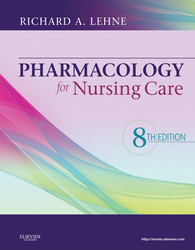Book Description
A favorite among nursing students, Pharmacology for Nursing Care, 8th Edition, features a uniquely engaging writing style, clear explanations, and unmatched clinical precision and currency to help you gain a solid understanding of key drugs and their implications -- as opposed to just memorization of certain facts. Compelling features such as a drug prototype approach, use of large and small print to distinguish need-to-know versus nice-to-know content, and a focus on major nursing implications save you study time by directing your attention on the most important, need-to-know information. The new edition also features an abundance of content updates to keep you ahead of the curve in school and in professional practice.
- UNIQUE! Engaging writing style with clear explanations makes content easy to grasp and even enjoyable to learn.
- A drug prototype approach uses one drug within each drug family to characterize all members of its group to help you learn about related drugs currently on the market and drugs that will be released once you begin practice.
- UNIQUE! Special Interest Topic boxes address timely issues in pharmacology and connect pharmacology content with current trends.
- Large print/small print design distinguishes essential "need-to-know" information from "nice-to-know" information.
- Limited discussion of adverse effects and drug interactions keeps your limited study time focused on only the most clinically important information.
- Reliance on up-to-date evidence-based clinical guidelines ensures that therapeutic uses are clinically relevant.
- Integrated and summarized nursing content demonstrates the vital interplay between drug therapy and nursing care.
- Coverage of dietary supplements and herbal interactions equips you to alert patients and caregivers to the potential dangers of certain dietary supplements, including interactions with prescribed and over-the-counter drugs and herbal therapies.
- Additional learning features provide a touchstone for study and review as you complete reading assignments and build a foundation of pharmacologic knowledge.
- Updated drug content and related nursing content reflect the very latest FDA drug approvals, withdrawals, and evidence-based therapeutic uses.
- Expanded and updated content on medication safety prepares you to pass the NCLEX Examination and practice safe medication administration in the clinical setting.
- Expanded coverage of pharmacogenomics introduces you to the many different genetic factors that influence drug therapy.
- New information on electronic prescribing primes you for nursing practice in the 21st century, as electronic prescribing systems become more common in the clinical setting.
- Updated coverage of evidence-based clinical treatment guidelines, particularly those for cholesterol and diabetes management, promotes evidence-based practice in nursing pharmacology.
- New chapter (Chapter 39) on nicotine and tobacco abuse highlights our growing understanding of the unique addictive properties of nicotine and the nursing considerations for helping patients improve their health through smoking cessation.
- Canadian drug names are now included and highlighted with a maple leaf icon to familiarize U.S readers with other trade names they may see and to make the book more useful for Canadian students.
I. INTRODUCTION
1. Orientation to Pharmacology
2. Application of Pharmacology in Nursing Practice
3. Drug Regulation, Development, Names, and Information
II. BASIC PRINCIPLES OF PHARMACOLOGY
4. Pharmacokinetics
5. Pharmacodynamics
6. Drug Interactions


 (0 rating)
(0 rating) 




